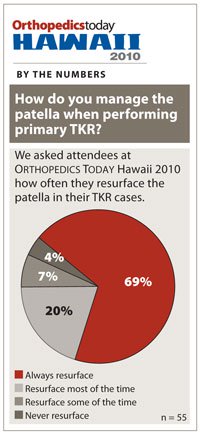Data indicate patella replacement may not be necessary
Data retrieved from European joint replacement registries have led one investigator to conclude that the majority of primary total knee arthroplasties may not require patella resurfacing.
Michael J. Dunbar, MD, FRCSC, PhD, a professor of orthopedic surgery at Dalhousie University in Halifax, Nova Scotia, Canada, told the attendees of the 11th Annual Current Concepts in Joint Replacement Spring Meeting that evidence-based data show some countries perform patellar resurfacing in less than 10% of cases.
However, conventional randomized trials comparing patella resurfacing with nonresurfacing are generally single-centered and underpowered; hence, “most find no difference in outcomes, so they tend to generate more heat than illuminate the problem,” Dunbar said.
Changes
In reality, “we are talking about a moving target. The prostheses are changing. Certainly the biggest change has been a move from a universal-type component to that of an anatomical component.”
|
|
Patients are also changing. “They are younger, heavier and have higher demands. But more importantly, I think they have higher expectations,” he said.
Moreover, techniques have changed. “In particular, we have better understanding of rotational alignment of components and the effect it has on patellar tracking,” Dunbar told Orthopedics Today.
But perhaps the most confounding factor is the standard effect size, or how much of an impact a standardized effect has on a patient.
Standard effect size “is the atomic bomb of health care,” Dunbar said. “The intervention of the surgery itself acts as a noise. In other words, the signal becomes noise and it becomes difficult to tease subtle variations in outcomes.”
Revision risk
In one Swedish study co-authored by Dunbar, about 27,000 knees from the Swedish Knee Arthroplasty Registry that had a 98% follow-up at 14 years, found statistically significant patient satisfaction in cases of patella resurfacing.
Another study of approximately 65,000 patients from the same registry found a 1.27 risk ratio for an unresurfaced patella. “So if you have an unresurfaced patella, you are more likely to get revised,” Dunbar said.
Careful interpretation
A third study of about 135,000 patients from the Australian National Joint Replacement Registry reveals nearly the same risk ratio: 1.25.

“We need to be careful, though, when interrupting this data because there is a bias with respect to the unresurfaced patella being revised,” Dunbar said. “If you have two identical patients in front of you – one with a resurfaced patella and the other with an unresurfaced patella – both complaining of anterior knee pain, you are more likely to take the unresurfaced patella back to the OR for resurfacing.”
Additionally, the results on an isolated patella resurfacing “are really quite dismal,” Dunbar said. More than 50% of patients are dissatisfied with revision for only a patella component.
Nonetheless, meta-analysis in the literature indicates anterior knee pain is greater with an unresurfaced patella, as well as an increased revision rate and a higher degree of patient dissatisfaction.
Internationally, Sweden is now performing patella resurfacing on less than 10% of patients (from a spike of over 80% in 1984), compared to Denmark and Canada, where the figure is over 50%. Dunbar attributes the sharp decrease in patella resurfacing in Sweden to the gradual replacement of the universal component with an anatomic component.
“If you look at the unresurfaced group, there is a better cumulative proportional distribution of satisfaction in the anatomic vs. the universal,” he said.
Revisions in the unresurfaced group also tend to be earlier and simpler, whereas resurfacing can potentially become problematic and lead to late revisions. Because total knee arthroplasty (TKA) patients are younger and heavier, “it may make sense to save their bone and only resurface selectively in the elderly,” Dunbar said. – by Bob Kronemyer
Reference:
- Dunbar, MJ. Rethinking Patella Replacement: Is it really necessary? Paper 37. Presented at the 11th Annual Current Concepts in Joint Replacement Spring Meeting. May 23-26. Las Vegas.
- Michael J. Dunbar, MD, FRCS(C), PhD, 1796 Summer St., Suite 4822, Halifax, Nova Scotia B3H 3A7, Canada; 902-494-2211; e-mail: michael.dunbar@dal.ca.

